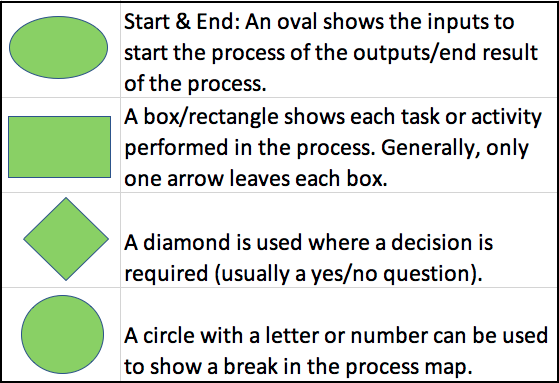A process map is a workflow diagram developed to document activities across a process.
Taking a step back, a process is simply a series of steps that we go through in order to complete a task or achieve some specific purpose--in other words, how do things get done?
Our daily lives involve many processes, either at work or as a consumer. In this tutorial, we will focus on a consumer example.
When we take a process, break it down into various steps, show it pictorially, we can make a process map.
To start, you would write out a very detailed narrative of the process and all of the steps involved.
Next, you would turn the steps into a pictorial diagram using these symbols.

Here is an example of a process map detailing a consumer's decision-making process about being hungry for pizza.

The oval represents the input that starts the process: I am hungry for pizza. What to do about it?
The first step in the process is to consider where to get pizza--an activity represented by a rectangle.
Then, a question arises. Do I have loyalty to a certain place? Is there somewhere that I always order from, that I want to order from again?
If the answer is yes, then the process ends with me placing my order.
If the answer is no, I go through more steps, represented by more rectangles, such as looking at ads or coupons and deciding which deal or offer is most attractive.
After completing these tasks, once again, the process ends with me placing my order.
Now, process maps can be a lot more detailed than this. They can involve a lot more steps and questions.
For instance, I could have taken this from where I place my order and continued on with the next process, such as:
As mentioned, though, this is a very simplified example of how the decision-making process is represented pictorially.
So, why do we use process mapping?
Well, it helps people and firms to break down exactly how things get done, so it provides a better understanding of the processes.
It can help to illustrate any areas along the way that might need improvement; many processes are complex and it helps to evaluate these holistically.
Process mapping is used in many different applications, although today the majority of processes are not documented in this way.
It is a relatively new process, but because of its dynamic nature, it is:
It is especially being used in holistic operational assessments of efficiency and in developing and analyzing solutions that are sustainable.
Source: Adapted from Sophia instructor Kate Eskra.